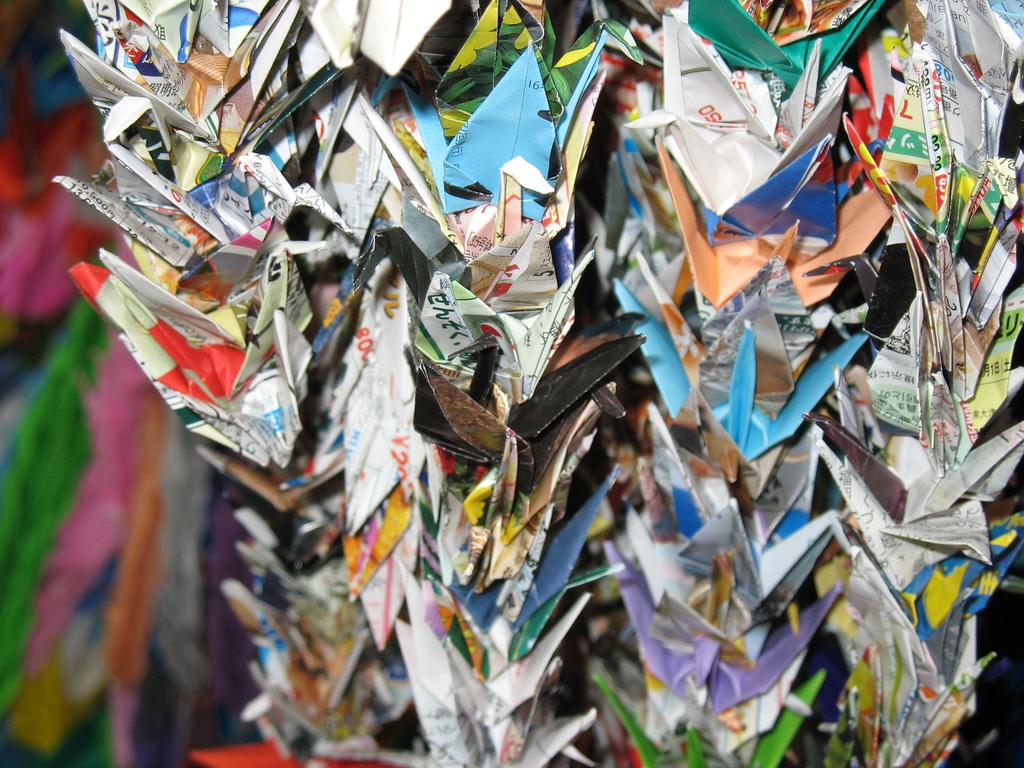Origami — A Tradition, A Hope
 Contributed by
Marie Nadal Sharma
November 21, 2015
Contributed by
Marie Nadal Sharma
November 21, 2015

If you venture into the Hiroshima Peace Memorial Park, you’ll find your footsteps drawn to the Children’s Peace Monument, a tall structure surrounded by innumerable, colourful paper cranes, offerings from around the world in a bid for peace.
At the top of the monument stands the statue of a little Japanese girl, an innocent victim of the atomic bomb devastation that took the lives of thousands on that fateful day in 1945, and continued to do so in future years through the lingering effects of radiation. The young girl immortalised in the statue is Sadako Sasaki, and her story continues to inspire nations around the world to give peace a chance.
The Story
Sadako was just two years old when the atom bomb came crashing down on Hiroshima, changing the life of millions in a heartbeat, and plunging Hiroshima into history as the first city to experience such an explosion. Sadako and her family remained safe, even though they lived just a mile away from the hypocenter, and Sadako grew into an energetic young girl who loved to run.
Towards the end of 1954, however, she was diagnosed with Leukaemia, the dreaded ‘Atom Bomb Disease’ caused by the radiation from the b
omb, and was admitted into the Hiroshima Red Cross Hospital. A young girl’s dreams for life were suddenly uncertain and insecure.
Sadako’s friend visited her in the hospital and told her about an old Japanese lore, that if a person would fold one thousand paper cranes, her wish would come true. This gave Sadako hope and purpose as she spent her time in origami, painstakingly folding paper cranes, desperately hoping it would cure her of the devastating condition.
She made a thousand cranes, and then some more, but her wish for healing remained unfulfilled, and she succumbed to the illness anyway.

The Peace Memorial was built in remembrance of Sadako and all the other children who had lost their lives following that fateful event in Japan's history. Even today, the tradition of folding paper cranes remains alive, with millions of colourful paper cranes offered before the monument each year in a symbolic plea for peace.

While paper cranes and their deep significance have played a part in elevating the art of origami to an international stage, this art of folding paper has long been part of Japan's identity ever since traditional Japanese origami was practiced in the Edo Period (1603 - 1867). Research shows the oldest known written document regarding Japanese origami to be a kyoka, a short poem written by Ihara Saikaku in 1680. This was ceremonial in nature, rooted in the ways of the Samurai. Ceremonial origami consists of a formal way of wrapping. In his 1682 book, 'Koshoku Ichidai Otoko', Saikaku also described an origami of Jiyoku-no Tori.
This was a representational origami, sometimes called recreational origami. The well-known Orizuru or crane falls under this type of origami. Hiden Senbazuru (How to Fold a Thousand Cranes), published in 1797, is perhaps the world's oldest book on origami, offering detailed instructions for folding the paper crane.
Origami began to be used as a teaching tool in the kindergarten and elementary school levels during the Meiji period (1868 - 1912). The Meiji Restoration, and the subsequent exchanges between Japan and Europe saw the fusion of European and Japanese origami. Japanese origami was greatly influenced by Friedrich Wilhelm August Fröbel, a German educator, whose method of teaching derived from European tradition origami. The evolution of origami as we know it today perhaps began at this time, and has formed the core of traditional origami.
Origami is popular all over the world even today, but it is only in Japan that it continues to form a significant part of the nation's cultural identity.
Visit the Them You and Me page to find out more about Marie's work.
This post was originally published on Them You and Me blog and has been reposted on Executive Lifestyle with the permission of the author.
Images Credits (Creative Commons via Flickr.com):
Building world peace and remembering Sadako Sasaki by WilliamN
Children's Peace Monument by throgers
Hiroshima Cranes by Ken Chen
Did you enjoy this post? Please comment, like and share!











Sorry, the comment form is closed at this time.